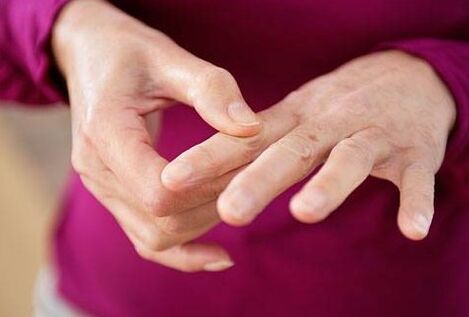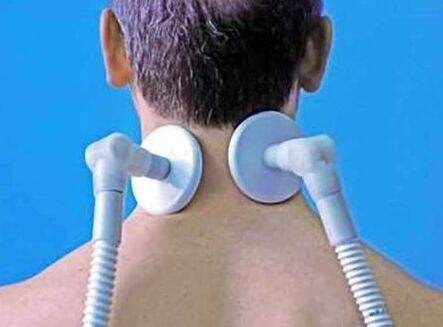The cervical osteochondrosis develops most often in adults, but a child can occur due to certain circumstances. If signs of such a disease are characteristic, you should contact a therapist or a narrow specialist neurologist.

Degenerative dystrophic destruction of the spine's neck disk characterizes the cervical osteochondrosis. The gradual progress of the disease leads to the damage to the grandeur, the adjacent vertebrae and the band apparatus. Many wrongly believe that osteochondrosis is the deposition of salts. However, such an explanation is fundamentally wrong. Salt can actually be deposited in different joints, for example due to the development of gout, for example in other pathologies.
Thanks to the muscle system, the backbone of the human neck, consisting of seven vertebrae, will take place. In this area, the muscles are poorly developed, which causes tiredness and cramps occur due to the long -term tension. In the future, the mobility of the cervical vertebrae will be limited. As a result of this disease, the spinal discs are gradually destroyed, which provokes the beginning of the first stage of osteochondrosis. In the absence of treatment, the disease continues to lead and causes all larger lesions of the spine. In order to prevent the development of complications, the first signs of pathology must observe in good time and take suitable measures.
In most cases, people like cervical osteochondrosis are confronted with people whose lifestyle ensures a minimum of physical activity and sitting work. In such a person, the first characteristics can most likely manifest themselves at the age of 25 to 30 years. In children from child to adolescence, the disease is less common, but can also occur due to an incorrect lifestyle or false inheritance, other irritating factors.
Development stages of pathology and their inherent symptoms
The entire development process of osteochondrosis of the cervical spine is divided into 4 main stages, each of which certain symptoms are accompanied. The treatment completely depends on the established severity of the disease. For example, the first preclinical stage does not require medication. In order to improve the patient's condition, it is recommended to radically check the lifestyle - carry out physical exercises and eat properly. The characteristics that are characteristic in this phase: the excessive tension of the muscles of the entire back, the fast appearance of a feeling of fatigue, a small but tangible pain in the moments of the curves and tendencies of the head. The main disadvantage in this case can differentiate between the fact that only a few people teach due to such symptoms due to importance, which is why they do not turn to the hospital immediately.

The following symptoms are characteristic of the second osteochondrosis:
- The pain when moving the head becomes more intense and regularly gives the shoulders, hands, even the lower back;
- Pain syndrome can occur in a quiet state;
- There is causal headache;
- Attention is scattered, the work capacity is reduced.
All symptoms mentioned above cannot remain unnoticed. At this stage of the disease, the patient is looking for medical help. The strengthening of the pain is due to the distance between the intervertebral discs and the violations of the nerves. An even greater deterioration of the situation takes place in the third stage. In this case, the pain in the neck constantly disturbs, the muscles of the hands become very weak, and numbness occurs from time to time. In general symptoms, dizziness and weakness become the patient's daily companion. The cervical spine loses mobility.
Unbearable pain in the neck, shoulders, arms, ears in the ears, a complete impairment of the coordination and the appearance of obvious signs of other diseases show the beginning of the last fourth level of osteochondrosis. At the same time, intermediate discs are destroyed and the pathological process continues along the spine on other departments. Such a degree of illness is difficult to treat, while at the doctor's discretion, surgical intervention may be necessary. With the appearance of symptoms such as: pain in the neck and crunch in the event of head movements, hands, dizziness, nausea, headache, hands as well as tiredness and problems with coordination should become an alarming signal that indicates real health problems. Do not delay a visit to the doctor, it is best to contact a therapist or immediately to a neuropathologist.
In the progression process of cervical osteochondrosis, violations of the spine can occur. Different sensitive and motor disorders can occur, depending on which spine have suffered:
- Partly or complete loss of the sensitivity of the occipital region in every part of the neck, in the shoulders and in the arms;
- Pain in the areas of the neck, shoulders, the forearms, the hands, to the fingers;
- Doubleity of the language, therefore impaired;
- Acceptance of the muscle tone from the head and neck;
- Problems with the breathing function, pain in the heart and liver.

The protruding edges of the vertebrae can squeeze arteries through which blood penetrates into the brain. Thus, the blood circulation in the brain is disturbed and additional symptoms occur: a sharp change in mood, insomnia, causeless fear, fear, irritability. At the same time, a cramp of blood vessels can not only occur headache, but also eye pain. Patients often notice the appearance of "flying" in the eyes, sometimes fainting is possible.
The reasons for the development of cervix osteochondrosis
The most common cause of the occurrence of cervical osteochondrosis is seen as a sitting lifestyle in connection with inadmissible, unbalanced nutrition. Often not only lazy people suffer from their nature, but also those whose profession obliges most of the time to spend on the same unpleasant pose: office workers, drivers of vehicles, etc. Such a lifestyle provokes a constant cargo of the cervical vertebrae, which is why muscle pasms occur. The appearance of degenerative processes in the discs is due to a violation of metabolic processes and blood circulation. Other reasons for the development of cervical osteochondrosis are:
- Excess weight through unhealthy nutrition;
- Rheumatism, scoliosis, posture problems, flat feet;
- Trauma of spine and neck;
- Regular stress, nervous overvoltage;
- hereditary reason;
- Congenital social development of the cervical vertebrae.
Too eager to sports, which means that excessively intensive physical activity can also become the previous factor in cervical osteochondrosis. The primary disease under such conditions is usually a disc. The latter characterizes dystrophic diseases in intervertebral discs, mainly lumbar and cervical discord. In this case, osteochondrosis is a result of a disc. In addition to the exclusion of strong physical exertion, this diagnosis, complex, drug and physiotherapeutic treatment is required.

The consequences of progressive pathology
A distinction should be made between the complications that can occur in the development of osteochondrosis of the cervix region:
- Hernia and lead in the spine-in-in-third stage of the spine are formed due to the rapid progress of the underlying disease;
- The growth of bone tissues or the formation of osteophytes are often projections. Osteophytes have an irritating effect on the muscles nearby and increase their sound. The pressure on the intervertebral discs therefore increases. In addition, educated osteophytes can cause narrowing of arteries;
- Flattening of the spine - a decrease in the intervertebral disc hole leads to a decrease in the height between the intervertebral discs. The risk of subluxation of the cervical vertebrae with a sharp turn of the head increases;
- Spondyloli or shift of the spine does not occur as often as other complications above. When occurring, even death can even cause death. Any minimal change in the position of the intervertebral disc with the highest probability leads to paralysis, a significant shift - until death.
The cervical osteochondrosis always provokes an increase in blood pressure. In addition, the transition of the underlying disease contributes from one stage to the progress of high blood pressure from the first to the third degree, in which the pressure exceeds the 180 mm brand. Treatment directly hypertension helps to reduce the severity of the symptoms, but only temporarily. In the event of a non -healed osteochondrosis, it is impossible to get rid of increased blood pressure. In the case of disc damage between 4 and 5 cervical vertebrae, there is a complication, as periarthritis occurs. It characterizes the clamping of the nerves that are in the context of the shoulder joint. At the same time, severe pain occurs in the shoulder, which has a negative impact on the mobility of the entire limb. In addition, manifestations of osteochondrosis cannot be based on signs of heart disease, for example angina pectoris, but thanks to diagnostic measures, it is possible to distinguish diseases with a high level of accuracy.
It is impossible to determine the osteochondrosis of the cervical spine by palpation and consequence of a visual medical examination. Based on the history collected, the doctor can only assume that exactly osteochondrosis became the cause of certain symptoms. In order to confirm or refute such an assumption, the diagnosis is required. The most optimal way today is MRI or magnetic resonance therapy. With this method you can take all bone structures into account, the presence of intermediate hernia, identify the size of the osteophytes and other complications that are characteristic of cervical osteochondrosis. Another, somewhat less informative path is computer tomography. However, you can determine a diagnosis, determining the size of the hernia because your presence can be difficult.

Treatment of cervical osteochondrosis
The treatment of osteochondrosis of the cervix region is always complex and complex. The duration and saturation depends on the stage of development of the disease, on the individual characteristics of the patient and the existence of other, simultaneous diseases. It should be differentiated among the main groups of medication that are frequently prescribed in the second and further phase:
- Analgetics or pain relievers. The means listed contribute to temporarily reducing the pain. If the pain is too pronounced, the local blockade of novocaine is used.
- Non -steroidal anti -inflammatory medication and steroid anti -inflammatory medication. Not steroids are safer, they have an analgesic effect and can become an alternative to ordinary analgesics. In the event that you do not relieve any pain, steroid medication is used.
- Antidepressants and sedatives - maternity herb, tincture by Valerian. Their purpose is due to two factors: if the cause of the osteochondrosis is a nervous overwhelming or if the pain is so serious that it has a negative impact on the psyche. The use of such medicines should be carried out under strict observation, since each of the medication has a number of contraindications and makes them addicted.
- Musorelaxants that help relieve muscle cramps. In combination with anti -inflammatory drugs, you have an analgesic effect.
- Vasransdilators who contribute to improving blood circulation.
- Medicines to increase immunity and normalize metabolic processes are ideal for B- and C vitamins.
The complex of these drugs is symptomatic treatment. Compliance with all recommendations from the doctor and the adoption of the prescribed course will help to eliminate the pain and to eliminate all unpleasant manifestations of the disease. However, the therapeutic course does not end there. If the main features are eliminated, which makes the quality of life worsen, you can take over the restoration of the cervix region to minimize the risk of relapse to the disease in the near future. Unfortunately, a big mistake of many people is that they consider themselves completely healthy after the symptoms disappear and give up the treatment. In this situation, osteochondrosis will certainly remember after a while.
Physiotherapy and traditional medicine
The following physiotherapeutic methods are successfully used to treat cervical osteochondrosis:

- Medical sports lessons - are carried out exclusively under the supervision of a qualified specialist, since false exercises with serious lesions of the intervertebral discs can no longer violate tissue.
- Manual therapy - is a manual effect on certain areas of the patient's body.
- Therapeutic massage;
- Reflexual zone massage and as a variety of acupuncture;
- Electrophoresis, balneotherapy, laser therapy, UFO etc.
Each of the above -mentioned methods has a number of contraindications, which is particularly important for those who have an anamnesis of other diseases that are not related to osteochondrosis of the cervical spine. The decision on the adequacy of the use of a specific method remains with the applicable doctor. It may not be certain to carry out such measures of your own free will. As for traditional medicine, you can use the grass of a saberfish, Bran. Fig. It is also recommended to reduce salt intake. A responsible approach to the treatment of cervix osteochondrosis enables the disease to be sure to get rid of. Let this process take a considerable time, but only a complex therapy reduces the likelihood that the disease disease contains a minimum development.



























